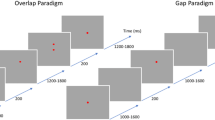Abstract
In this report, we introduce an experimental method for eyeblink measurement by utilizing Doppler effect phenomena. In the cognitive science literature, eyeblink has been proposed as a complex phenomenon and acts as a representative of higher nervous processes. We developed an experimental setup in which the measurement of the eyeblink was conducted using a Doppler sensor accompanied by an accelerometer and an EOG (electrooculography) recording. From our experimental results, we found that the Doppler frequency related to blinking contains a dominant frequency at 2 Hz. Finally, we showed that when blinking is accompanied with head and body movements, eyeblink signal is separable by deploying the principal component analysis (PCA).

















Similar content being viewed by others
References
Stern JA, Skelly JJ (1984) The eye blink and workload consideration. Proc Human Factor SOL 2X:942–944
Baumstimler Y, Parrot J (1971) Stimulus generalization and spontaneous blinking in man involved in a voluntary activity. J Exp Psychoi 88:95–102
Ohira O (1996) Eyeblink activity in a word-naming task as a function of semantic priming and cognitive load. Percept Mot Skills 82:835–842
Staszek K, Wincza K, Gruszczynski S (2012) Driver’s drowsiness monitoring system utilizing microwave Doppler sensor. In: Proc. MIKON, vol. 2, pp 623–626
Ryan SB, Detweiler KL, Holland KH et al (2006) A long-range, wide field-of-view infrared eyeblink detector. J Neurosci Methods 152:74–82
Kwon K, Shipley RJ, Edirisinghe M et al (2013) High-speed camera characterization of voluntary eye blinking kinematics. Kinematics J R Soc Interface 10:20130227
Kim Y (2015) Detection of eye blinking using Doppler sensor with principal component analysis. IEEE Antennas Wirel Propag Lett 14:123–126
Karhunen J, Joutsensalo J (1993), Representation and separation of signals using nonlinear PCA type learning. In: Neural Networks, vol 7, 1, pp 113–127
Jolliffe IT (1986) Principal component analysis. Springer, New York
Acknowledgements
This report is supported by JSPS KAKENHI 2530406.
Author information
Authors and Affiliations
Corresponding author
About this article
Cite this article
Maleki, A., Uchida, M. Non-contact measurement of eyeblink by using Doppler sensor. Artif Life Robotics 23, 279–285 (2018). https://doi.org/10.1007/s10015-017-0414-x
Received:
Accepted:
Published:
Issue Date:
DOI: https://doi.org/10.1007/s10015-017-0414-x




